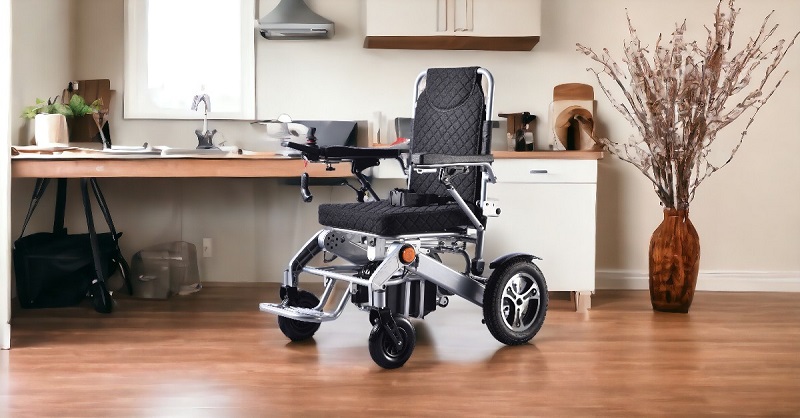Finding the right wheelchair size can be tricky. Standard wheelchair seat widths range from 16 inches for a narrow adult to 20 inches for a wide adult. Our guide dives into everything you need to know about choosing the perfect wheelchair width, ensuring comfort and mobility.
Let’s get started—you won’t want to miss this!
Understanding Wheelchair Width and Sizing

Wheelchair width matters — it impacts comfort and access. The right size helps people move easily, fitting through doorways without trouble.
Average seat width (16-20 inches)
The average seat width for manual wheelchairs falls between 16 and 20 inches, catering to a range of users. Narrow adult models start at 16 inches, which is suitable for those requiring a more compact size.
For the typical user, an 18-inch wide seat offers balanced comfort and support. Those needing extra space might opt for the wider 20-inch seats. This variety ensures that wheelchairs can accommodate users of different body sizes efficiently.
Standard options include 16, 18, and 20 inches widths, covering narrow to wide adult needs. Such diversity in sizing makes it easier to find the right fit for comfort and maneuverability.
Whether navigating through tight corners or ensuring ample space for movement, selecting the correct seat width plays a crucial role in a wheelchair’s functionality and the user’s ability to enjoy everyday activities.
Overall width (23-25 inches)
Wheelchairs have an overall width of 23 to 25 inches. This measurement includes the seat, wheels, and armrests, making wheelchairs wide enough to pass through most doorways comfortably.
However, users need to check specific doorway widths at home or in public spaces to ensure smooth access. Different wheelchair models offer various features, but maintaining a manageable width helps navigate indoor and outdoor environments easily.
Considering factors such as materials used and whether the wheelchair is manual or electric can also impact its width. Some power wheelchairs might be on the wider side due to extra components necessary for operation.
Next up, let’s delve into what influences wheelchair width variations..
Factors that Affect Wheelchair Width

Wheelchair width isn’t one-size-fits-all — it changes based on who’s using it and how. From the wheelchair type to a user’s body, many things tweak that number.
Type of wheelchair
Fixed-width and folding are the main types of wheelchairs. Fixed-width models usually measure between 16 and 25 inches wide. Folding wheelchairs are a bit more versatile, with widths ranging from 15 to 26 inches.
The choice depends on user needs; fixed-width is great for stability, while folding versions offer easy storage and transport.
Each type serves different users. Bariatric wheelchairs support heavier weights, electric ones give effortless mobility, and transport chairs make short trips easier. Manual bariatric models help those needing sturdy support; lightweight chairs suit active lifestyles.
Choosing hinges on personal preference, body size, and specific requirements like footrests or larger wheels for comfort and convenience.
User’s body size
The user’s body size is critical in choosing the right wheelchair. Seat width and depth need to fit the user’s build perfectly. This is crucial because around 80-90% of wheelchair users are using chairs that don’t properly match their bodies, leading to discomfort or even health issues.
A well-fitting chair supports mobility and daily activities without hindrance.
Key measurements like seat width, back height, seat depth, and seat-to-floor height are essential for a snug fit. For example, an average adult might find comfort in standard manual wheelchairs with typical dimensions.
However, individuals who are either smaller or larger than average may need pediatric wheelchairs or bariatric models designed for heavier weights. Each user’s unique body dimensions dictate the size of the wheelchair needed to ensure optimal comfort and functionality.
Specific needs and preferences
Moving beyond body size, specific needs, and preferences are pivotal in picking the perfect wheelchair. Factors like seat depth, back support, and weight capacity must align with individual requirements to ensure comfort and mobility.
A wheelchair fitted properly enhances posture—leading to a better quality of life. For example, someone with limited lower limb strength may benefit from a lightweight, easy transport option.
Accessories and features can make a big difference, too. Swing-away footrests or elevating leg rests accommodate varying levels of mobility impairment. Power bariatric wheelchairs cater to obese individuals by offering wider widths and sturdier frames.
Meanwhile, narrow transport chairs navigate tight spaces effortlessly for those frequently facing narrow doorways or crowded places. Each wheelchair design has its purpose—to match the user’s lifestyle seamlessly while providing necessary support and independence.
Doorway Width for Wheelchair Access

Doorways need to be at least 32 inches wide for wheelchair access. This allows wheelchairs to move freely without getting stuck.
Recommended by ADA (24-27 inches)
The Americans with Disabilities Act (ADA) sets standards to ensure doorways are wide enough for wheelchair access. They recommend a minimum clear width of 32 inches for a single wheelchair passage.
This requirement helps make buildings and homes more accessible and navigable for those using wheelchairs.
Doorways should ideally range from 24 to 27 inches wide for smooth entry and movement, considering the overall wheelchair width. Making these adjustments allows users to get around easily without the hassle of tight squeezes or needing assistance.
Following ADA guidelines ensures spaces meet accessibility needs, making them welcoming for everyone.
Making doorways more accessible for wheelchairs
After considering the ADA’s recommended doorway width, let’s focus on making those doorways more accessible for wheelchairs. This ensures users can freely move in and out without hassle.
- Widen doorways – Aim for a minimum of 32 inches, but 36 inches is ideal for smoother access.
- Install offset hinges – These allow doors to open wider, adding precious extra inches for navigation.
- Remove door thresholds – Flat surfaces eliminate tripping hazards and ease wheelchair movement.
- Use swing-away or pocket doors – They maximize space by sliding or swinging out of the way.
- Lower peepholes and locks – Adjust for seated accessibility, ensuring security and visibility are not compromised.
- Create level landings outside doors – Ensure enough space for maneuvering before entering or exiting.
- Consider automatic doors – For hands-free operation, offering greater independence for wheelchair users.
Resizing a doorway for wheelchair users
Resizing doorways makes homes more wheelchair accessible. It allows users to move freely and comfortably. Here’s how to do it:
- Measure the current doorway width – Check if your door is less than 36 inches wide, the standard accessibility width.
- Determine the needed width – Remember, wheelchairs vary in size, but aiming for at least 36 inches can accommodate most.
- Consult a professional – Before knocking down walls, get advice from an expert in home modifications for accessibility.
- Check for load-bearing walls – Some walls support your home’s structure. Know which ones you can safely modify.
- Choose swing-away hinges – These allow doors to open wider, sometimes enough to meet the necessary width without major changes.
- Consider pocket doors – Removing and installing traditional doors can save space and widen access points.
- Remove moldings and trim – Sometimes, extra inches are hidden behind decorative trims. Taking these off might do the trick.
- Widen the doorway – If modifications still fall short, it’s time to physically widen the doorway by removing part of the wall.
- Finish with smooth edges – After widening, ensure all edges are smooth and won’t snag on a wheelchair or scratch users.
- Adjust surrounding areas – Ensure that hallways leading up to the door are also wide enough for easy navigation.
Sharp turns after a doorway
Sharp turns right after a doorway challenges wheelchair users. Doors need to be wide enough, but that’s not all. Wheelchairs require space to maneuver, especially for turning. ADA standards highlight the importance of clearance and turning spaces.
This ensures wheelchairs can navigate through doorways without hassle.
Making every turn accessible is key in adapting homes for wheelchair use. Not only should door widths meet ADA recommendations, but planning for extra space around corners is essential.
This allows smoother transitions and easier movement throughout the home, making it accessible for everyone with mobility impairments.
Adapting the Home for Wheelchair Accessibility
Making your home wheelchair-friendly might seem daunting initially, but it’s doable with the right changes. Let’s dive into how to widen doorways and hallways for smoother rides around the house.
Hallway width
For wheelchair users to move easily, hallways need to be wide enough. The minimum advised width is 36 inches. This lets wheelchairs pass without trouble. For new homes or remodels, aiming for a hallway width of 46 inches is better.
It gives extra space and comfort for mobility.
Some homes have narrower spaces, but it’s crucial to keep the width over 32 inches at least. This ensures that even larger wheelchairs can fit through without bumping into walls. Making these adjustments helps everyone in the house move around more freely and safely.
Recommended door width
A home’s doorways must be wide enough to accommodate a wheelchair. The ADA suggests a clear width of 32 inches for accessibility. However, a wider frame is better for true ease of access, especially with sharp turns after entry.
Front doors should measure at least 36 inches wide, providing 32 inches of clearance. This size ensures wheelchairs can pass through without trouble.
Moving beyond the front door, adapting other home parts becomes essential for full accessibility.
New construction considerations
For new buildings, always think about making space for wheelchairs. Hallways and doors need to be wide enough. A good rule is to have doorways at least 32 inches wide and halls 36 inches across.
This makes it easy for wheelchair users to move around without bumps or scrapes.
Incorporate turning spaces in every room, especially bathrooms, where maneuvering can be tricky. Remember, all rooms should let a wheelchair turn fully—a key point in construction plans to ensure accessibility and comfort for everyone.
Choosing the Right Wheelchair for Your Needs

Picking the perfect wheelchair isn’t just about what catches your eye, it’s deeper. It’s about matching your body, lifestyle, and needs—a personal fit.
Seat width and depth
Choosing the right seat size in a wheelchair is crucial for comfort and mobility. Standard seat widths range from 16 inches (narrow adult) to 20 inches (wide adult). It’s important to measure across the widest part of the hips, buttocks, or thigh to find a size that fits well.
The goal is for the width to be enough to support the user without being too wide, making it hard to reach the wheels.
Seat depth also matters because it can press behind the knees and cut off circulation if it’s too long. It is too short, and it won’t support enough of the leg, which can reduce stability and comfort.
To get this right, measure from the back of the hip to just behind the knee while sitting straight. This ensures that when you buy a wheelchair—whether manual or electric—it matches your body’s needs perfectly.
Weight capacity
After considering the seat width and depth, it’s crucial to consider how much weight a wheelchair can support. Most general-use wheelchairs hold between 250 lbs and 350 lbs. This range suits many users well.
But, for those needing more, bariatric wheelchairs step in with a capacity of 300 to 700 pounds. These heavy-duty options ensure everyone finds a fit.
Lightweight versions cater to users up to 200 lbs, providing an option that’s easier to transport while still durable. Each type—standard, lightweight, or bariatric—meets specific needs.
Weight limits are key in choosing a wheelchair that’s both comfortable and safe. Always check this feature before making your selection; it ensures the chair can handle daily use without issues.
Specific features and options
Wheelchairs come with various features to meet the needs of users. Options include adjustable armrests, removable or swing-away footrests, and reclining backrests for added comfort.
Lightweight and portable models make transport easier. Electric wheelchairs offer power assistance, ideal for those who may not have the strength for a manual model. Each feature plays a crucial role in ensuring the wheelchair fits perfectly—matching unique sizes, shapes, and preferences.
For those requiring more support, heavy-duty wheelchairs provide increased weight capacity. Seat depth and back height adjustments cater to the user’s specific body dimensions. Evaluating these options ensures you find a wheelchair that’s just right—balancing functionality with personal needs.
Now, onto adapting your home to ensure it’s wheelchair accessible..
Seeking professional advice
Seeking professional advice is key to finding the right wheelchair. A health expert can guide you through the process. They help measure your body width and other dimensions needed for a snug fit.
This step ensures comfortable seating and good back support.
Experts know about different wheelchairs on the market – manual, active user, and electric. They use six measurements to choose the best size for you. This tailored approach leads to better posture and improved function in your daily life.
Trust a professional to make this important decision easier for you.
Conclusion
Finding the right wheelchair means knowing the width. Standard seat widths fall between 16 and 20 inches. Remember, your choice should match your body size and daily needs. If unsure, professional advice can guide you through sizes and features—making life smoother for everyone involved.
FAQs
1. What size wheelchair do I need?
To find your perfect fit, measure your hips at their widest point, then add about two inches for comfort. This number gives you an ideal seat width, but remember, wheelchairs also come in various sizes to meet different needs.
2. Can wheelchairs fit through doorways?
Most transport chairs and manual wheelchairs are designed to be slim enough—at about 22 to 26 inches—to easily slide through standard doorways without needing to remove the door.
3. Are there bigger wheelchairs for larger individuals?
Yes! Bariatric wheelchairs cater to those who need a bigger size, ranging from 35 to 45 inches widths, with heavy-duty frames built for extra support.
4. Do all wheelchairs have large back wheels?
Not all—the design varies by type. Transport wheelchairs often have smaller wheels because someone pushes them; meanwhile, most manual ones feature larger back wheels that users can push themselves.
5. What features should I consider besides width when choosing a wheelchair?
Consider comfort and mobility—like if swing-away footrests or lightweight frames matter to you—and how easy it is to operate in your daily spaces; these factors ensure you get one that fits your body and lifestyle.





